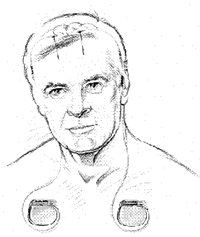This intervention is only for individuals who do not respond well to cognitive behavior therapy or medication.

What is deep brain stimulation (DBS)?
- DBS has been used since the mid 1980’s to treat the symptoms of movement disorders, such as Parkinson’s disease.
- DBS involves placing electrodes in targeted areas of the brain. Once the electrodes are in place, they are connected by wires under the skin to pulse generators under the skin (usually just below the collarbone).
- The pulse generator, sometimes called an “implantable neurostimulator,” contains a battery for power and a microchip to control the stimulation. A doctor uses a hand-held wand and small computer to control the pulse generator through the skin.
- These pulse generators are similar to pacemakers. The biggest difference is that in DBS the electrodes are in the brain instead of in the heart.
Does DBS work?
In the late 1990’s, based on positive research results in anterior capsulotomies, DBS researchers first implanted electrodes in the anterior capsule of treatment-resistant OCD patients. The early results were promising. Three of the first four patients experienced benefit. Since then, larger trials have been done and the target area of the brain has moved slightly to an overlapping part of the brain called the ventral capsule/ventral striatum (VC/VS).
A worldwide study found that out of 26 patients with treatment-resistant OCD, 61.5% responded positively to DBS. This response rate is similar to the other surgeries described above. However, comparisons must be tentative since the number of patients treated with DBS is still relatively small.
What are the benefits of DBS compared to other surgeries?
DBS requires opening the skull, but it does not require destroying any brain tissue. In the other surgeries listed above, there is a fixed amount of brain tissue that is destroyed. DBS allows for different amounts of electrical charge, giving the doctors a wider range of treatment.
Has DBS been approved for use in OCD?
The FDA recently approved DBS for treatment-resistant OCD under a Humanitarian Device Exemption (HDE). The HDE approval assumes a relatively small number of patients will receive the treatment. The placement of the electrodes, and the decision about how much stimulation is given, is crucial. Because DBS for treatment-resistant OCD is a very specialized procedure, it is recommended that treatment be given at institutions that have previous DBS experience.
Who is eligible for DBS?
Patients eligible for DBS will have had very little or no response to all currently available medicines and behavioral treatments for OCD.
How long does DBS need to continue?
At this point it appears that DBS needs to continue indefinitely for continued benefit. It is crucial that a psychiatrist with expertise in DBS be directly involved in a patient’s care over the months and years following surgery.
Want More Information on DBS?
Author: Darin D Dougherty, MD, Department of Psychiatry, Massachusetts General Hospital, Associate Professor of Psychiatry, Harvard Medical School
